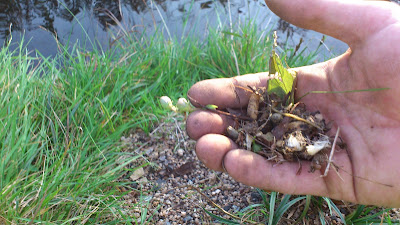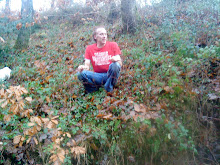Rocky Cliffs
Along the North Devon & Cornwall coast, leading up to Hartland Point; is this amazing stretch of coast, with barely any human settlements and rock strata, which as the picture below clearly shows; go all ways, including vertically. These rocks range from Quartzite, metamorphosed Slate, Red Sandstone and the odd igneous protrusion of granite. they are around 450'000'000(four hundred and fifty hundred million) years old and were laid down originally as sediment in the Devonian era. Around the same sort of time as life began to crawl out of the sea, and was beginning to find root in and around estuaries and rivers.
Because these rocks are so old; they have been compacted, crushed together by continental drift, partially melted and metamorphosed; they are tough and stand up to fierce pounding from the relentless crashing waves of the Atlantic Ocean, which this coastline faces head-on.
Cliff Plants
Unlike the flimsy Clays and Chalks, which make up most of the coasts of Southern Briton; these tough rocky high cliffs give much anchorage and therefore habitat to many surprisingly tough little plants:
Sea Pinks Armeria Maritima
Seen here, with tufts of low, tightly packed, dark green, blade-like foliage and clusters of pink flowers, held on extended little stems.
Left to their own devices and needing seemingly no help from me; these tough little plants occupy much of Briton's rocky cliff sides and tops, even growing on some heathland, near to the coast.
As a garden plant; the Thrift, as it is sometimes known, has been a great success mainly as a rockery plant, where it thrives, despite being a long way from the coast and it flowers almost continuously from June to October, here shown in mid September, clearly their best is over, but still throwing up new flowering stems, regardless of what nature and the brooding Atlantic may through at them.
Indeed; this strikes me as a highly adaptable species. I have some in my garden on Dartmoor, where they thrive and help to keep the weeds down on the rockeries, by growing in such tight clumps, so as not to allow the young germinating weed seed any light or nutrients.
Sea Pinks will flourish where little else will grow and will take root in any little rocky crack.
I do not have any plans to introduce Sea pinks to Dartmoor, I think they should remain a sea plant, in less nature causes them to make such a migration themselves.
No, today's expedition is merely to observe.
Samphire Crithmum Maritimum
The Common Rock Samphire, which by all accounts is not only edible, but considered quite a delicacy; is common on seaside cliffs and walls, such as these around the coastline.
The flowers would have been white and umbeliferious in nature.
The whole plant has a fleshy, succulent feel to it and it is very common.
Scurvy Grass Cochleria Officinalis/Pyrenaica/Danica/Anglica
Between these clumps of Sea Pinks can be seen; the little rosettes of fleshy leaves, shaped a bit like those of a violet.
Curiously named Scurvy Grass. I mean, the Scurvy bit's OK, because they are rich in Vitamin C and therefore would cure scurvy, but 'Grass'; It is neither a type of grass, nor dose it bear any kind of resemblance to a grass, so I guess that bit will remain a mystery for now.
Some species of Scurvy Grass grow in muddy estuaries and salt flats, others can grow way inland, often in road or railway cuttings.
I have added a few specimens of such a variety of this species, which I found many of, whilst cycling home, from Okehampton, on the road edges & in banks, going around & over the edges of Dartmoor, between Okehampton and Tavistock. I will see how they do, before deciding weather or not to introduce any varieties extensively to the High Moor.
 I collected the seeds I have today, from my last traumatic breakdown experience and the subsequent long hitch home:
I collected the seeds I have today, from my last traumatic breakdown experience and the subsequent long hitch home: I just hope my bike is fixed properly soon, else tree planting season will have to be catered for with public transport and/or the bicycle.
I just hope my bike is fixed properly soon, else tree planting season will have to be catered for with public transport and/or the bicycle.



















